Understanding Financial Statements of General Mills Inc.
VerifiedAdded on 2022/11/27
|11
|1963
|436
AI Summary
This document provides an in-depth understanding of the financial statements of General Mills Inc. including their income statement, balance sheet, and cash flow statement. It also discusses the stakeholders interested in the company's financial information and the auditors responsible for auditing their financial statements.
Contribute Materials
Your contribution can guide someone’s learning journey. Share your
documents today.
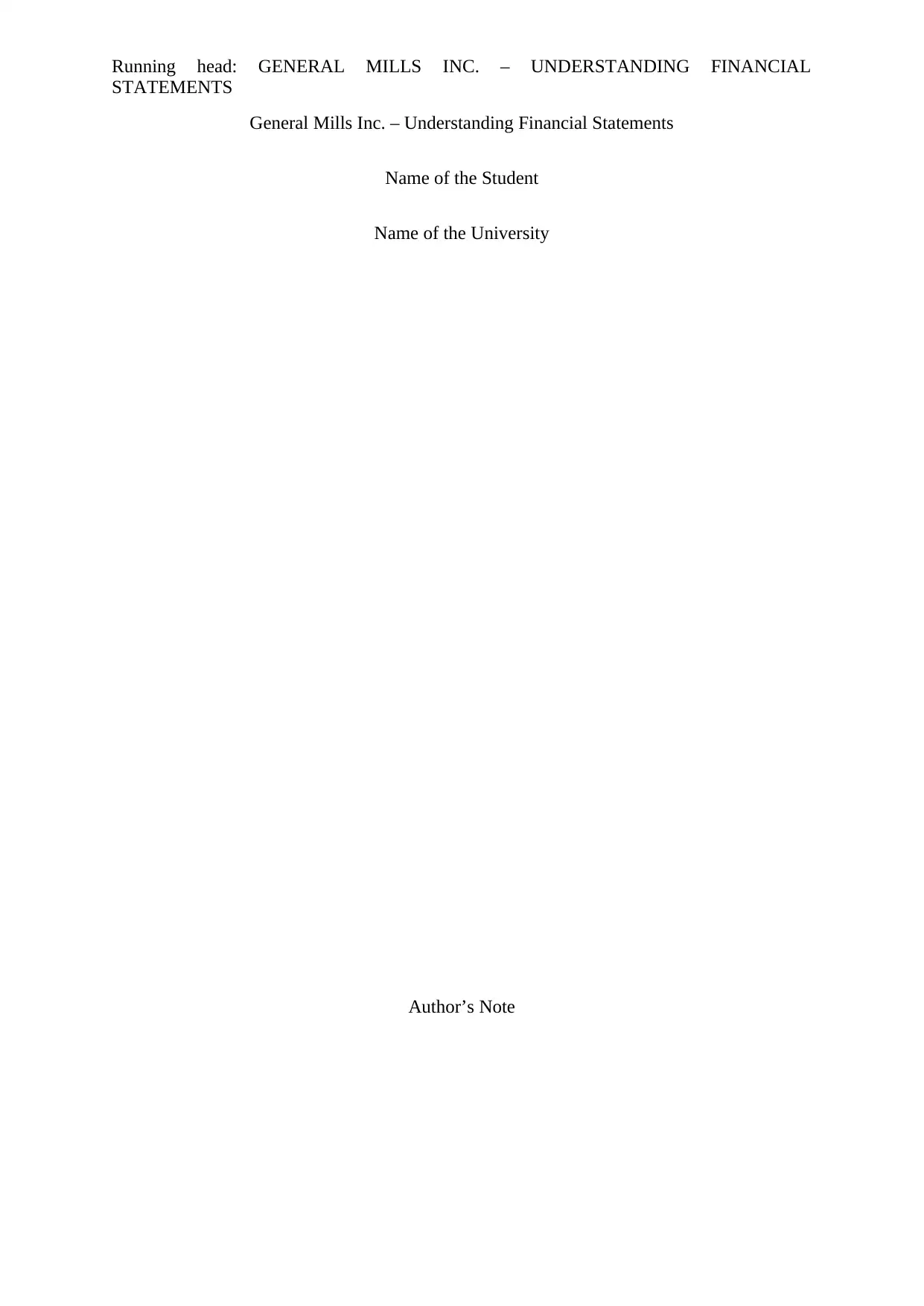
Running head: GENERAL MILLS INC. – UNDERSTANDING FINANCIAL
STATEMENTS
General Mills Inc. – Understanding Financial Statements
Name of the Student
Name of the University
Author’s Note
STATEMENTS
General Mills Inc. – Understanding Financial Statements
Name of the Student
Name of the University
Author’s Note
Secure Best Marks with AI Grader
Need help grading? Try our AI Grader for instant feedback on your assignments.
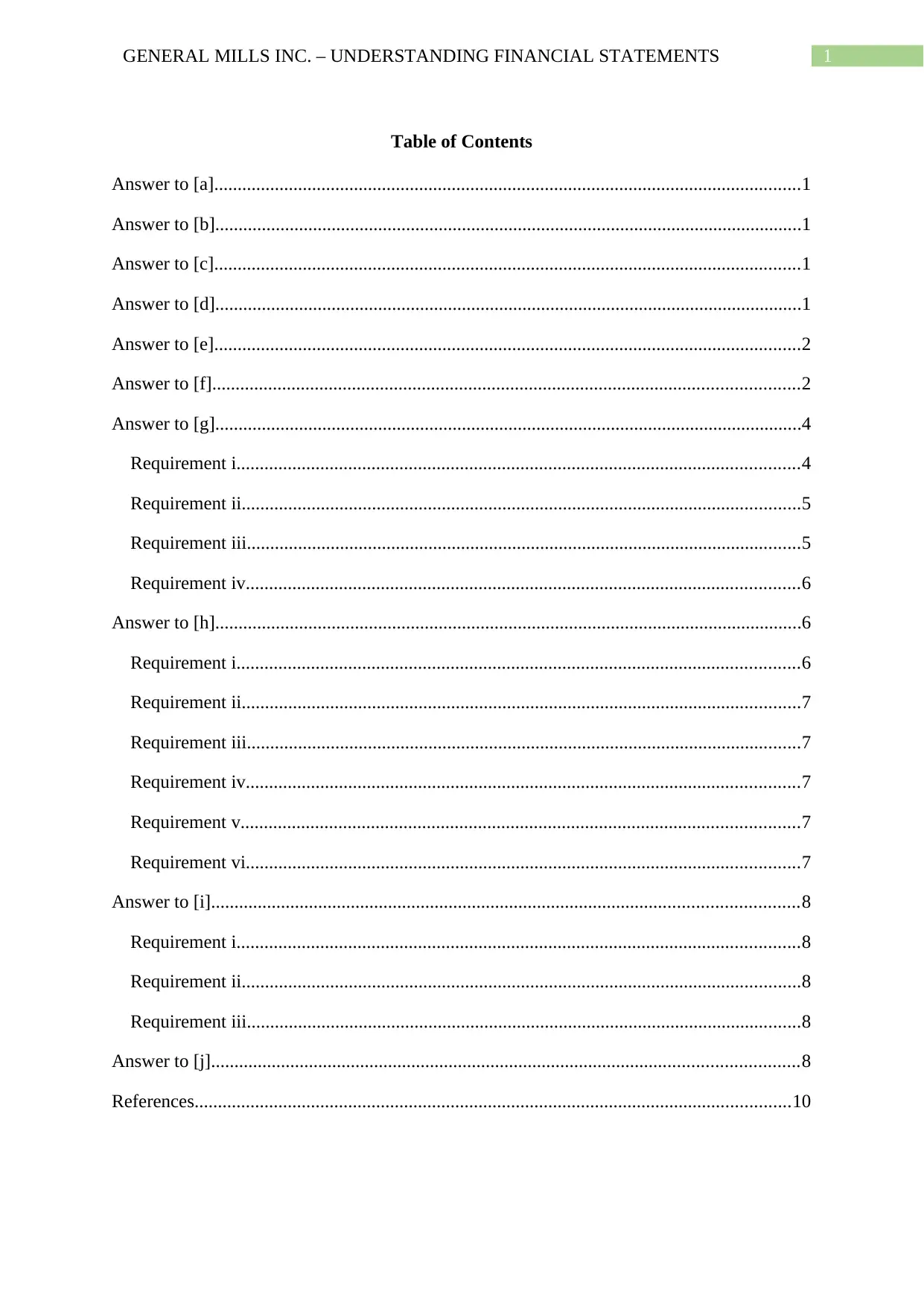
1GENERAL MILLS INC. – UNDERSTANDING FINANCIAL STATEMENTS
Table of Contents
Answer to [a]..............................................................................................................................1
Answer to [b]..............................................................................................................................1
Answer to [c]..............................................................................................................................1
Answer to [d]..............................................................................................................................1
Answer to [e]..............................................................................................................................2
Answer to [f]..............................................................................................................................2
Answer to [g]..............................................................................................................................4
Requirement i.........................................................................................................................4
Requirement ii........................................................................................................................5
Requirement iii.......................................................................................................................5
Requirement iv.......................................................................................................................6
Answer to [h]..............................................................................................................................6
Requirement i.........................................................................................................................6
Requirement ii........................................................................................................................7
Requirement iii.......................................................................................................................7
Requirement iv.......................................................................................................................7
Requirement v........................................................................................................................7
Requirement vi.......................................................................................................................7
Answer to [i]..............................................................................................................................8
Requirement i.........................................................................................................................8
Requirement ii........................................................................................................................8
Requirement iii.......................................................................................................................8
Answer to [j]..............................................................................................................................8
References................................................................................................................................10
Table of Contents
Answer to [a]..............................................................................................................................1
Answer to [b]..............................................................................................................................1
Answer to [c]..............................................................................................................................1
Answer to [d]..............................................................................................................................1
Answer to [e]..............................................................................................................................2
Answer to [f]..............................................................................................................................2
Answer to [g]..............................................................................................................................4
Requirement i.........................................................................................................................4
Requirement ii........................................................................................................................5
Requirement iii.......................................................................................................................5
Requirement iv.......................................................................................................................6
Answer to [h]..............................................................................................................................6
Requirement i.........................................................................................................................6
Requirement ii........................................................................................................................7
Requirement iii.......................................................................................................................7
Requirement iv.......................................................................................................................7
Requirement v........................................................................................................................7
Requirement vi.......................................................................................................................7
Answer to [i]..............................................................................................................................8
Requirement i.........................................................................................................................8
Requirement ii........................................................................................................................8
Requirement iii.......................................................................................................................8
Answer to [j]..............................................................................................................................8
References................................................................................................................................10
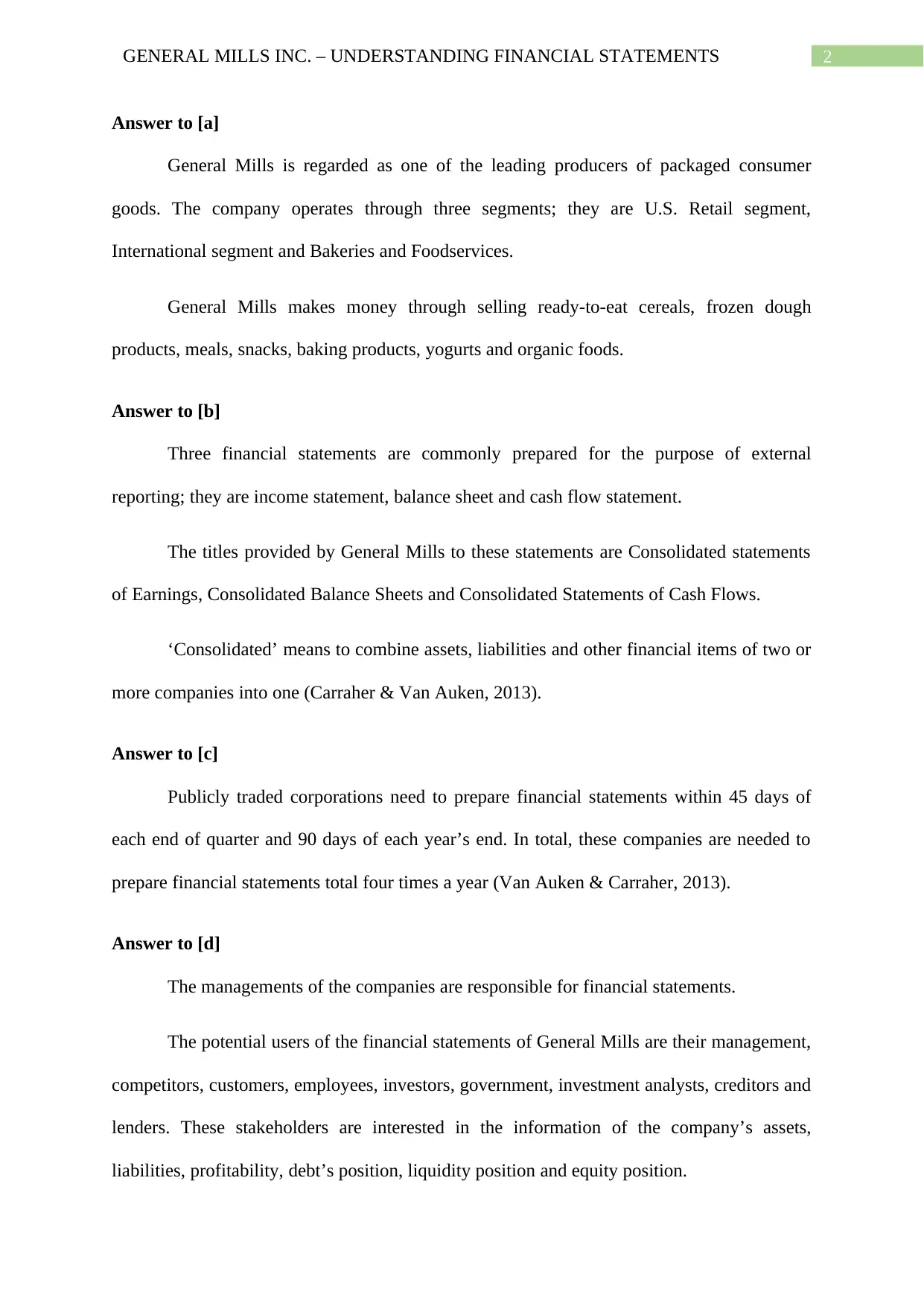
2GENERAL MILLS INC. – UNDERSTANDING FINANCIAL STATEMENTS
Answer to [a]
General Mills is regarded as one of the leading producers of packaged consumer
goods. The company operates through three segments; they are U.S. Retail segment,
International segment and Bakeries and Foodservices.
General Mills makes money through selling ready-to-eat cereals, frozen dough
products, meals, snacks, baking products, yogurts and organic foods.
Answer to [b]
Three financial statements are commonly prepared for the purpose of external
reporting; they are income statement, balance sheet and cash flow statement.
The titles provided by General Mills to these statements are Consolidated statements
of Earnings, Consolidated Balance Sheets and Consolidated Statements of Cash Flows.
‘Consolidated’ means to combine assets, liabilities and other financial items of two or
more companies into one (Carraher & Van Auken, 2013).
Answer to [c]
Publicly traded corporations need to prepare financial statements within 45 days of
each end of quarter and 90 days of each year’s end. In total, these companies are needed to
prepare financial statements total four times a year (Van Auken & Carraher, 2013).
Answer to [d]
The managements of the companies are responsible for financial statements.
The potential users of the financial statements of General Mills are their management,
competitors, customers, employees, investors, government, investment analysts, creditors and
lenders. These stakeholders are interested in the information of the company’s assets,
liabilities, profitability, debt’s position, liquidity position and equity position.
Answer to [a]
General Mills is regarded as one of the leading producers of packaged consumer
goods. The company operates through three segments; they are U.S. Retail segment,
International segment and Bakeries and Foodservices.
General Mills makes money through selling ready-to-eat cereals, frozen dough
products, meals, snacks, baking products, yogurts and organic foods.
Answer to [b]
Three financial statements are commonly prepared for the purpose of external
reporting; they are income statement, balance sheet and cash flow statement.
The titles provided by General Mills to these statements are Consolidated statements
of Earnings, Consolidated Balance Sheets and Consolidated Statements of Cash Flows.
‘Consolidated’ means to combine assets, liabilities and other financial items of two or
more companies into one (Carraher & Van Auken, 2013).
Answer to [c]
Publicly traded corporations need to prepare financial statements within 45 days of
each end of quarter and 90 days of each year’s end. In total, these companies are needed to
prepare financial statements total four times a year (Van Auken & Carraher, 2013).
Answer to [d]
The managements of the companies are responsible for financial statements.
The potential users of the financial statements of General Mills are their management,
competitors, customers, employees, investors, government, investment analysts, creditors and
lenders. These stakeholders are interested in the information of the company’s assets,
liabilities, profitability, debt’s position, liquidity position and equity position.
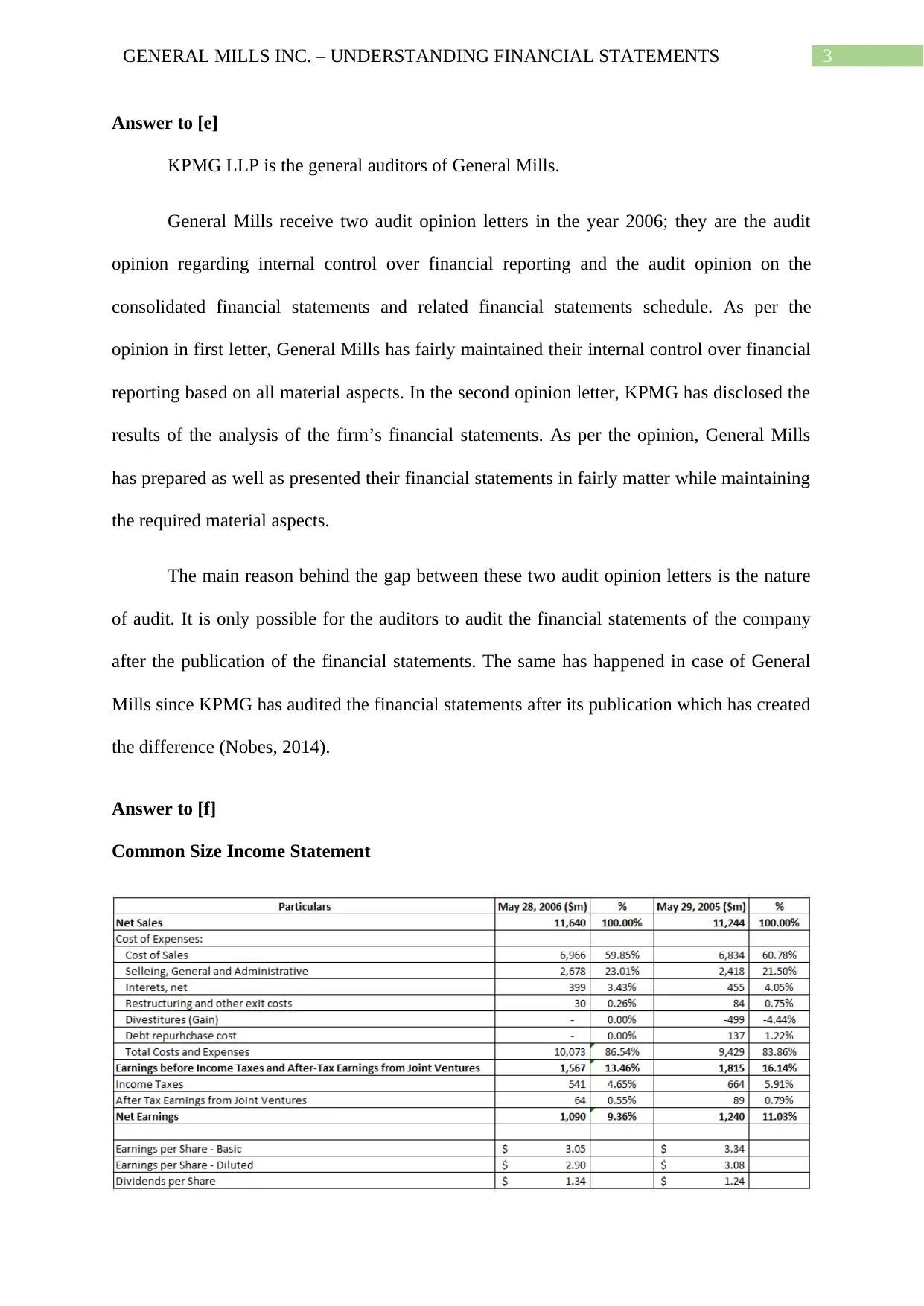
3GENERAL MILLS INC. – UNDERSTANDING FINANCIAL STATEMENTS
Answer to [e]
KPMG LLP is the general auditors of General Mills.
General Mills receive two audit opinion letters in the year 2006; they are the audit
opinion regarding internal control over financial reporting and the audit opinion on the
consolidated financial statements and related financial statements schedule. As per the
opinion in first letter, General Mills has fairly maintained their internal control over financial
reporting based on all material aspects. In the second opinion letter, KPMG has disclosed the
results of the analysis of the firm’s financial statements. As per the opinion, General Mills
has prepared as well as presented their financial statements in fairly matter while maintaining
the required material aspects.
The main reason behind the gap between these two audit opinion letters is the nature
of audit. It is only possible for the auditors to audit the financial statements of the company
after the publication of the financial statements. The same has happened in case of General
Mills since KPMG has audited the financial statements after its publication which has created
the difference (Nobes, 2014).
Answer to [f]
Common Size Income Statement
Answer to [e]
KPMG LLP is the general auditors of General Mills.
General Mills receive two audit opinion letters in the year 2006; they are the audit
opinion regarding internal control over financial reporting and the audit opinion on the
consolidated financial statements and related financial statements schedule. As per the
opinion in first letter, General Mills has fairly maintained their internal control over financial
reporting based on all material aspects. In the second opinion letter, KPMG has disclosed the
results of the analysis of the firm’s financial statements. As per the opinion, General Mills
has prepared as well as presented their financial statements in fairly matter while maintaining
the required material aspects.
The main reason behind the gap between these two audit opinion letters is the nature
of audit. It is only possible for the auditors to audit the financial statements of the company
after the publication of the financial statements. The same has happened in case of General
Mills since KPMG has audited the financial statements after its publication which has created
the difference (Nobes, 2014).
Answer to [f]
Common Size Income Statement
Secure Best Marks with AI Grader
Need help grading? Try our AI Grader for instant feedback on your assignments.
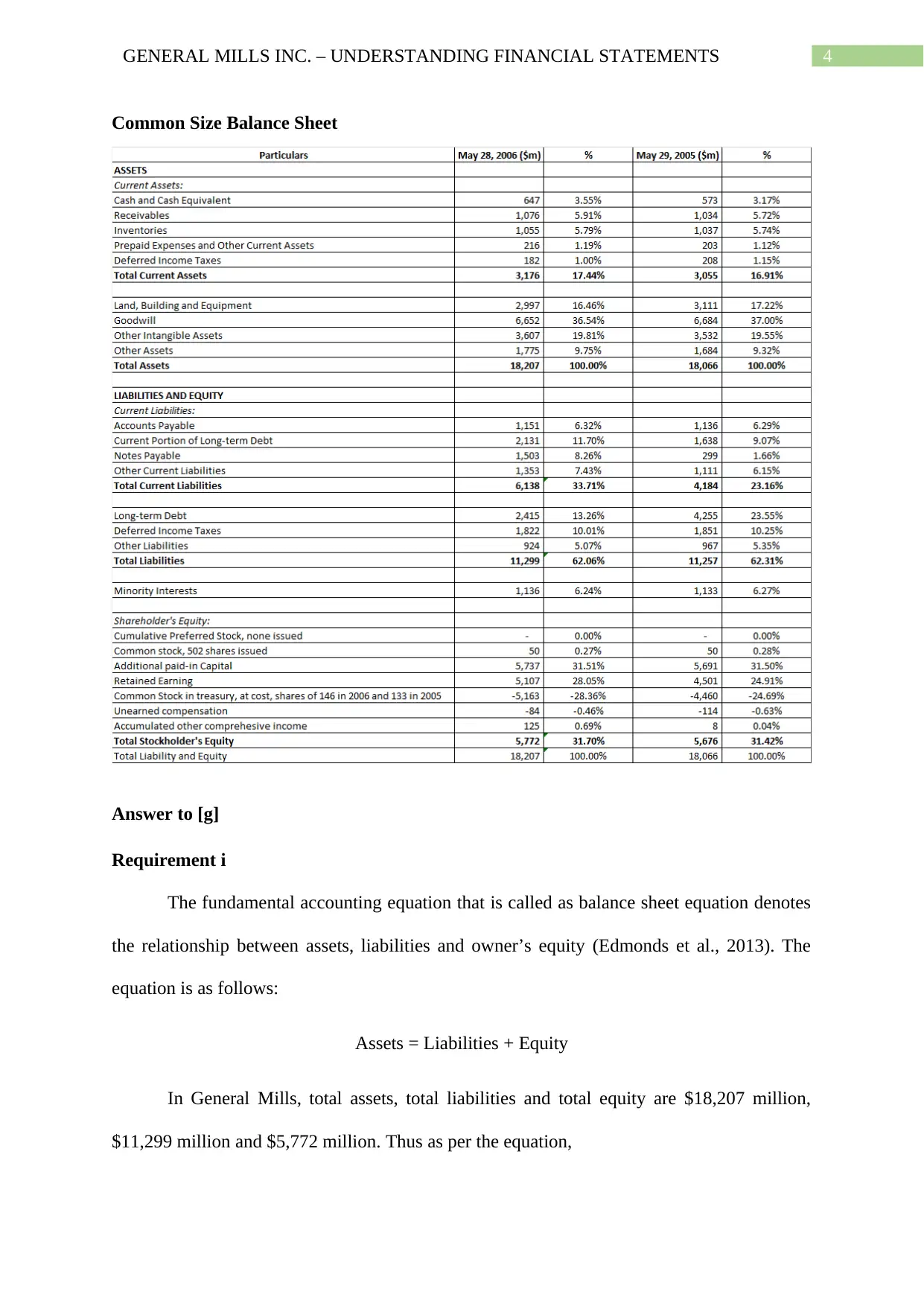
4GENERAL MILLS INC. – UNDERSTANDING FINANCIAL STATEMENTS
Common Size Balance Sheet
Answer to [g]
Requirement i
The fundamental accounting equation that is called as balance sheet equation denotes
the relationship between assets, liabilities and owner’s equity (Edmonds et al., 2013). The
equation is as follows:
Assets = Liabilities + Equity
In General Mills, total assets, total liabilities and total equity are $18,207 million,
$11,299 million and $5,772 million. Thus as per the equation,
Common Size Balance Sheet
Answer to [g]
Requirement i
The fundamental accounting equation that is called as balance sheet equation denotes
the relationship between assets, liabilities and owner’s equity (Edmonds et al., 2013). The
equation is as follows:
Assets = Liabilities + Equity
In General Mills, total assets, total liabilities and total equity are $18,207 million,
$11,299 million and $5,772 million. Thus as per the equation,
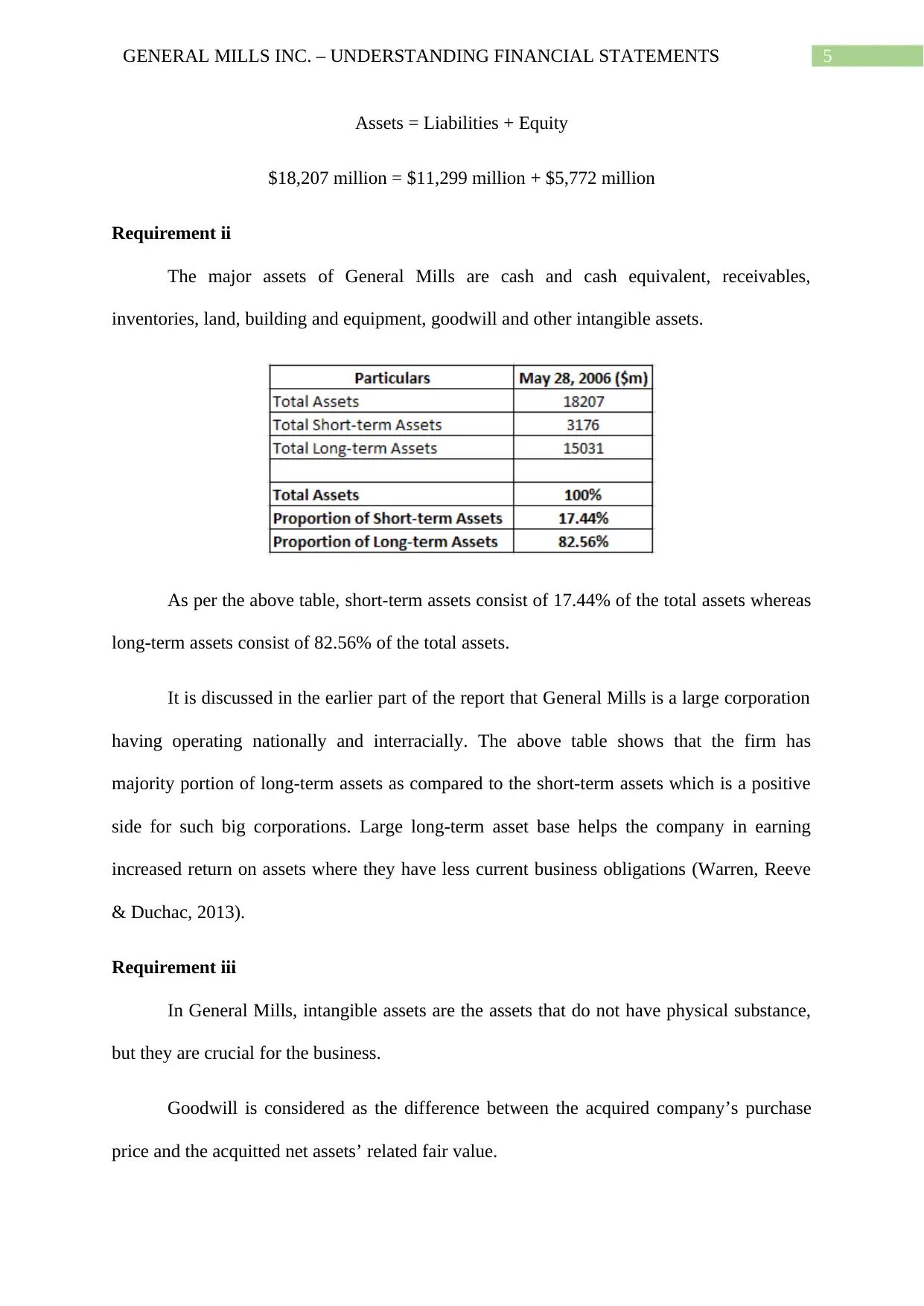
5GENERAL MILLS INC. – UNDERSTANDING FINANCIAL STATEMENTS
Assets = Liabilities + Equity
$18,207 million = $11,299 million + $5,772 million
Requirement ii
The major assets of General Mills are cash and cash equivalent, receivables,
inventories, land, building and equipment, goodwill and other intangible assets.
As per the above table, short-term assets consist of 17.44% of the total assets whereas
long-term assets consist of 82.56% of the total assets.
It is discussed in the earlier part of the report that General Mills is a large corporation
having operating nationally and interracially. The above table shows that the firm has
majority portion of long-term assets as compared to the short-term assets which is a positive
side for such big corporations. Large long-term asset base helps the company in earning
increased return on assets where they have less current business obligations (Warren, Reeve
& Duchac, 2013).
Requirement iii
In General Mills, intangible assets are the assets that do not have physical substance,
but they are crucial for the business.
Goodwill is considered as the difference between the acquired company’s purchase
price and the acquitted net assets’ related fair value.
Assets = Liabilities + Equity
$18,207 million = $11,299 million + $5,772 million
Requirement ii
The major assets of General Mills are cash and cash equivalent, receivables,
inventories, land, building and equipment, goodwill and other intangible assets.
As per the above table, short-term assets consist of 17.44% of the total assets whereas
long-term assets consist of 82.56% of the total assets.
It is discussed in the earlier part of the report that General Mills is a large corporation
having operating nationally and interracially. The above table shows that the firm has
majority portion of long-term assets as compared to the short-term assets which is a positive
side for such big corporations. Large long-term asset base helps the company in earning
increased return on assets where they have less current business obligations (Warren, Reeve
& Duchac, 2013).
Requirement iii
In General Mills, intangible assets are the assets that do not have physical substance,
but they are crucial for the business.
Goodwill is considered as the difference between the acquired company’s purchase
price and the acquitted net assets’ related fair value.
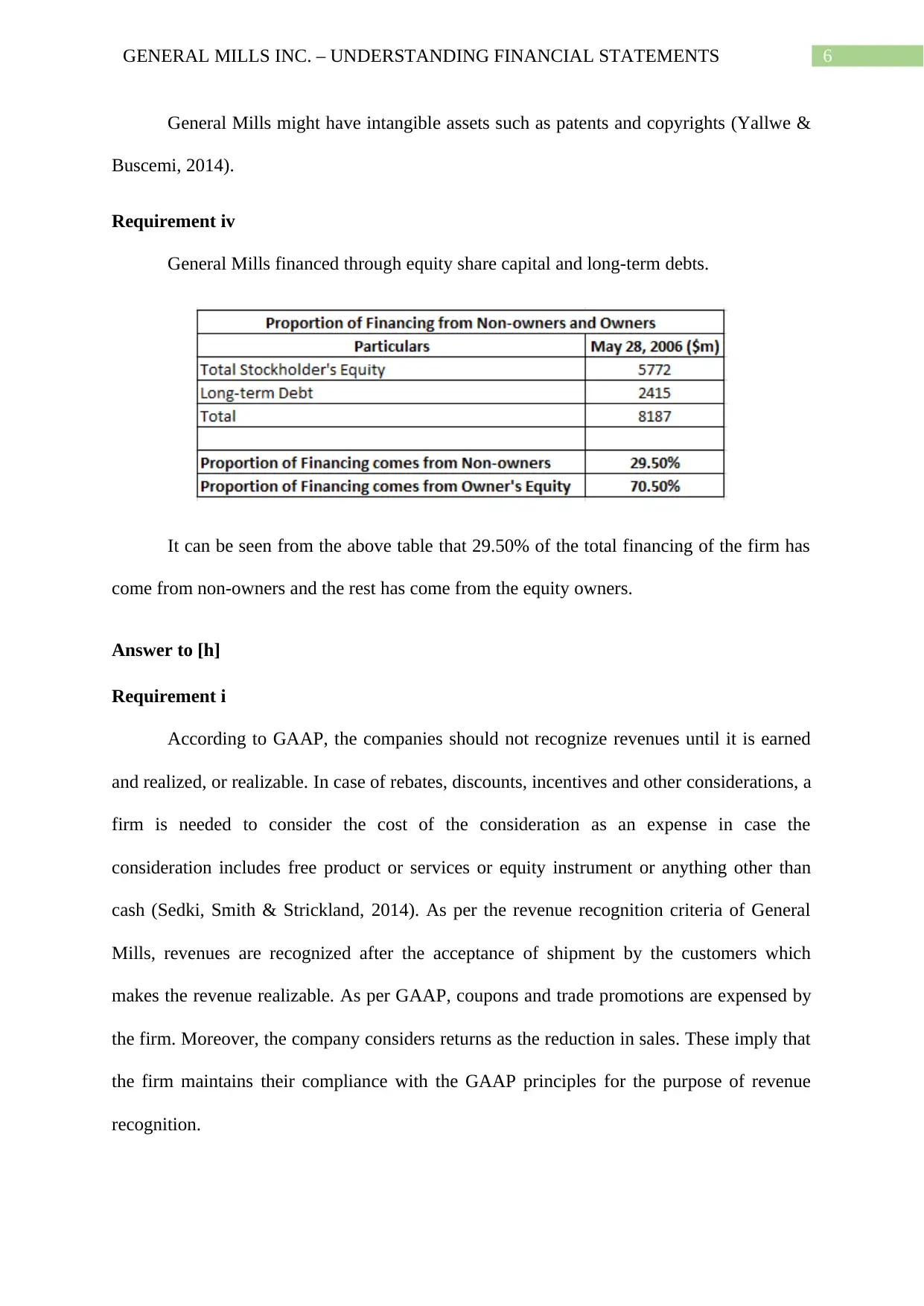
6GENERAL MILLS INC. – UNDERSTANDING FINANCIAL STATEMENTS
General Mills might have intangible assets such as patents and copyrights (Yallwe &
Buscemi, 2014).
Requirement iv
General Mills financed through equity share capital and long-term debts.
It can be seen from the above table that 29.50% of the total financing of the firm has
come from non-owners and the rest has come from the equity owners.
Answer to [h]
Requirement i
According to GAAP, the companies should not recognize revenues until it is earned
and realized, or realizable. In case of rebates, discounts, incentives and other considerations, a
firm is needed to consider the cost of the consideration as an expense in case the
consideration includes free product or services or equity instrument or anything other than
cash (Sedki, Smith & Strickland, 2014). As per the revenue recognition criteria of General
Mills, revenues are recognized after the acceptance of shipment by the customers which
makes the revenue realizable. As per GAAP, coupons and trade promotions are expensed by
the firm. Moreover, the company considers returns as the reduction in sales. These imply that
the firm maintains their compliance with the GAAP principles for the purpose of revenue
recognition.
General Mills might have intangible assets such as patents and copyrights (Yallwe &
Buscemi, 2014).
Requirement iv
General Mills financed through equity share capital and long-term debts.
It can be seen from the above table that 29.50% of the total financing of the firm has
come from non-owners and the rest has come from the equity owners.
Answer to [h]
Requirement i
According to GAAP, the companies should not recognize revenues until it is earned
and realized, or realizable. In case of rebates, discounts, incentives and other considerations, a
firm is needed to consider the cost of the consideration as an expense in case the
consideration includes free product or services or equity instrument or anything other than
cash (Sedki, Smith & Strickland, 2014). As per the revenue recognition criteria of General
Mills, revenues are recognized after the acceptance of shipment by the customers which
makes the revenue realizable. As per GAAP, coupons and trade promotions are expensed by
the firm. Moreover, the company considers returns as the reduction in sales. These imply that
the firm maintains their compliance with the GAAP principles for the purpose of revenue
recognition.
Paraphrase This Document
Need a fresh take? Get an instant paraphrase of this document with our AI Paraphraser
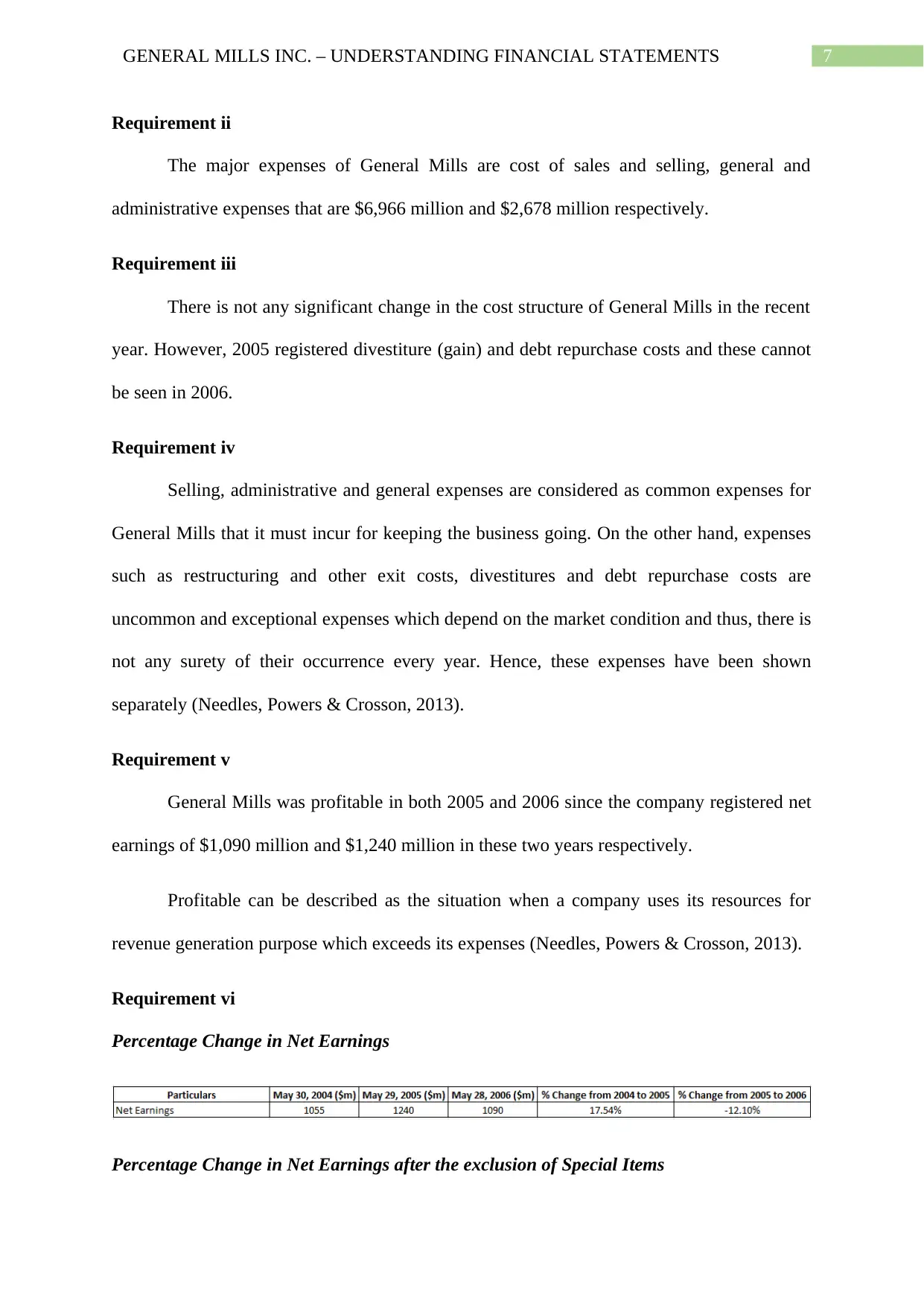
7GENERAL MILLS INC. – UNDERSTANDING FINANCIAL STATEMENTS
Requirement ii
The major expenses of General Mills are cost of sales and selling, general and
administrative expenses that are $6,966 million and $2,678 million respectively.
Requirement iii
There is not any significant change in the cost structure of General Mills in the recent
year. However, 2005 registered divestiture (gain) and debt repurchase costs and these cannot
be seen in 2006.
Requirement iv
Selling, administrative and general expenses are considered as common expenses for
General Mills that it must incur for keeping the business going. On the other hand, expenses
such as restructuring and other exit costs, divestitures and debt repurchase costs are
uncommon and exceptional expenses which depend on the market condition and thus, there is
not any surety of their occurrence every year. Hence, these expenses have been shown
separately (Needles, Powers & Crosson, 2013).
Requirement v
General Mills was profitable in both 2005 and 2006 since the company registered net
earnings of $1,090 million and $1,240 million in these two years respectively.
Profitable can be described as the situation when a company uses its resources for
revenue generation purpose which exceeds its expenses (Needles, Powers & Crosson, 2013).
Requirement vi
Percentage Change in Net Earnings
Percentage Change in Net Earnings after the exclusion of Special Items
Requirement ii
The major expenses of General Mills are cost of sales and selling, general and
administrative expenses that are $6,966 million and $2,678 million respectively.
Requirement iii
There is not any significant change in the cost structure of General Mills in the recent
year. However, 2005 registered divestiture (gain) and debt repurchase costs and these cannot
be seen in 2006.
Requirement iv
Selling, administrative and general expenses are considered as common expenses for
General Mills that it must incur for keeping the business going. On the other hand, expenses
such as restructuring and other exit costs, divestitures and debt repurchase costs are
uncommon and exceptional expenses which depend on the market condition and thus, there is
not any surety of their occurrence every year. Hence, these expenses have been shown
separately (Needles, Powers & Crosson, 2013).
Requirement v
General Mills was profitable in both 2005 and 2006 since the company registered net
earnings of $1,090 million and $1,240 million in these two years respectively.
Profitable can be described as the situation when a company uses its resources for
revenue generation purpose which exceeds its expenses (Needles, Powers & Crosson, 2013).
Requirement vi
Percentage Change in Net Earnings
Percentage Change in Net Earnings after the exclusion of Special Items
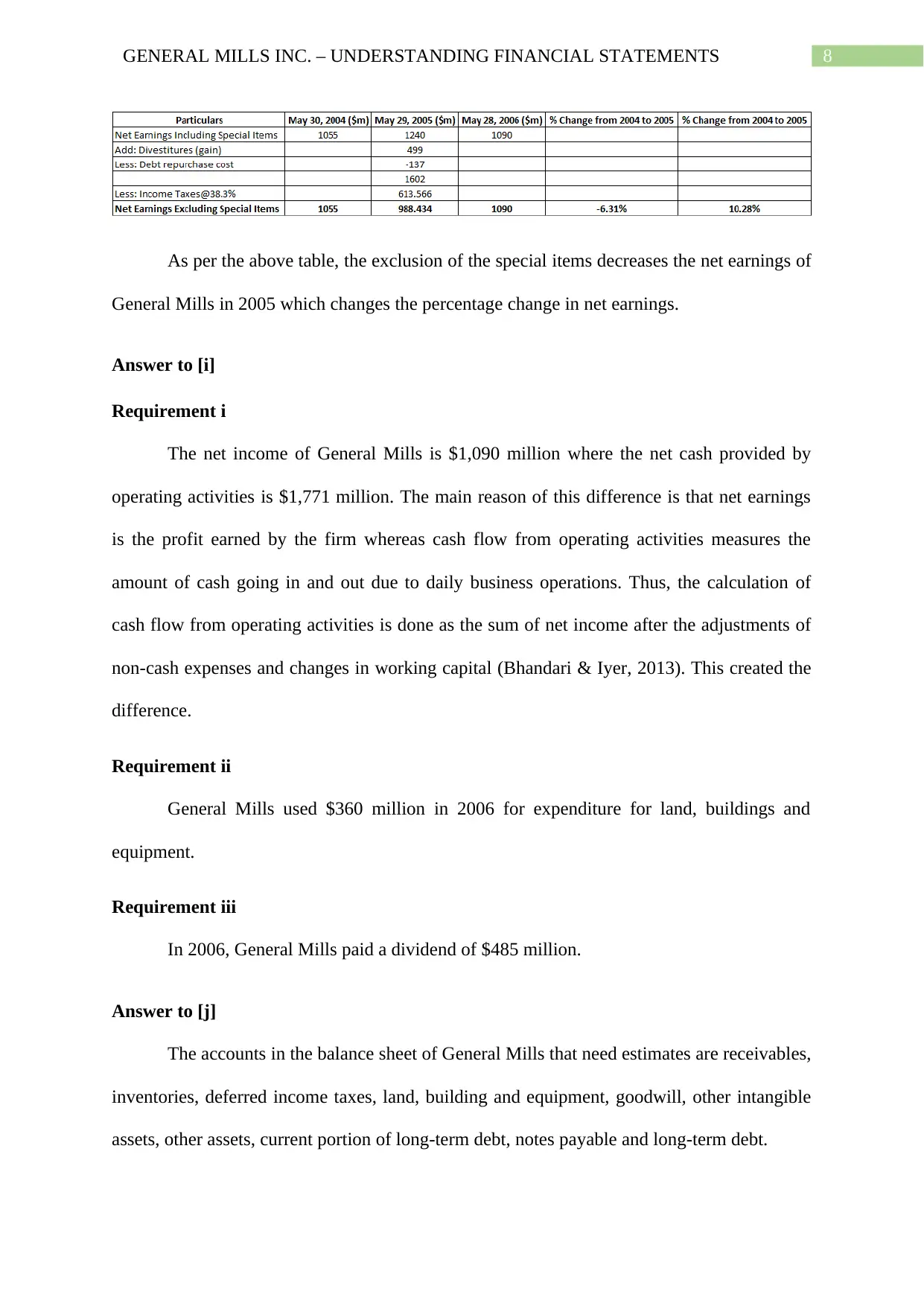
8GENERAL MILLS INC. – UNDERSTANDING FINANCIAL STATEMENTS
As per the above table, the exclusion of the special items decreases the net earnings of
General Mills in 2005 which changes the percentage change in net earnings.
Answer to [i]
Requirement i
The net income of General Mills is $1,090 million where the net cash provided by
operating activities is $1,771 million. The main reason of this difference is that net earnings
is the profit earned by the firm whereas cash flow from operating activities measures the
amount of cash going in and out due to daily business operations. Thus, the calculation of
cash flow from operating activities is done as the sum of net income after the adjustments of
non-cash expenses and changes in working capital (Bhandari & Iyer, 2013). This created the
difference.
Requirement ii
General Mills used $360 million in 2006 for expenditure for land, buildings and
equipment.
Requirement iii
In 2006, General Mills paid a dividend of $485 million.
Answer to [j]
The accounts in the balance sheet of General Mills that need estimates are receivables,
inventories, deferred income taxes, land, building and equipment, goodwill, other intangible
assets, other assets, current portion of long-term debt, notes payable and long-term debt.
As per the above table, the exclusion of the special items decreases the net earnings of
General Mills in 2005 which changes the percentage change in net earnings.
Answer to [i]
Requirement i
The net income of General Mills is $1,090 million where the net cash provided by
operating activities is $1,771 million. The main reason of this difference is that net earnings
is the profit earned by the firm whereas cash flow from operating activities measures the
amount of cash going in and out due to daily business operations. Thus, the calculation of
cash flow from operating activities is done as the sum of net income after the adjustments of
non-cash expenses and changes in working capital (Bhandari & Iyer, 2013). This created the
difference.
Requirement ii
General Mills used $360 million in 2006 for expenditure for land, buildings and
equipment.
Requirement iii
In 2006, General Mills paid a dividend of $485 million.
Answer to [j]
The accounts in the balance sheet of General Mills that need estimates are receivables,
inventories, deferred income taxes, land, building and equipment, goodwill, other intangible
assets, other assets, current portion of long-term debt, notes payable and long-term debt.
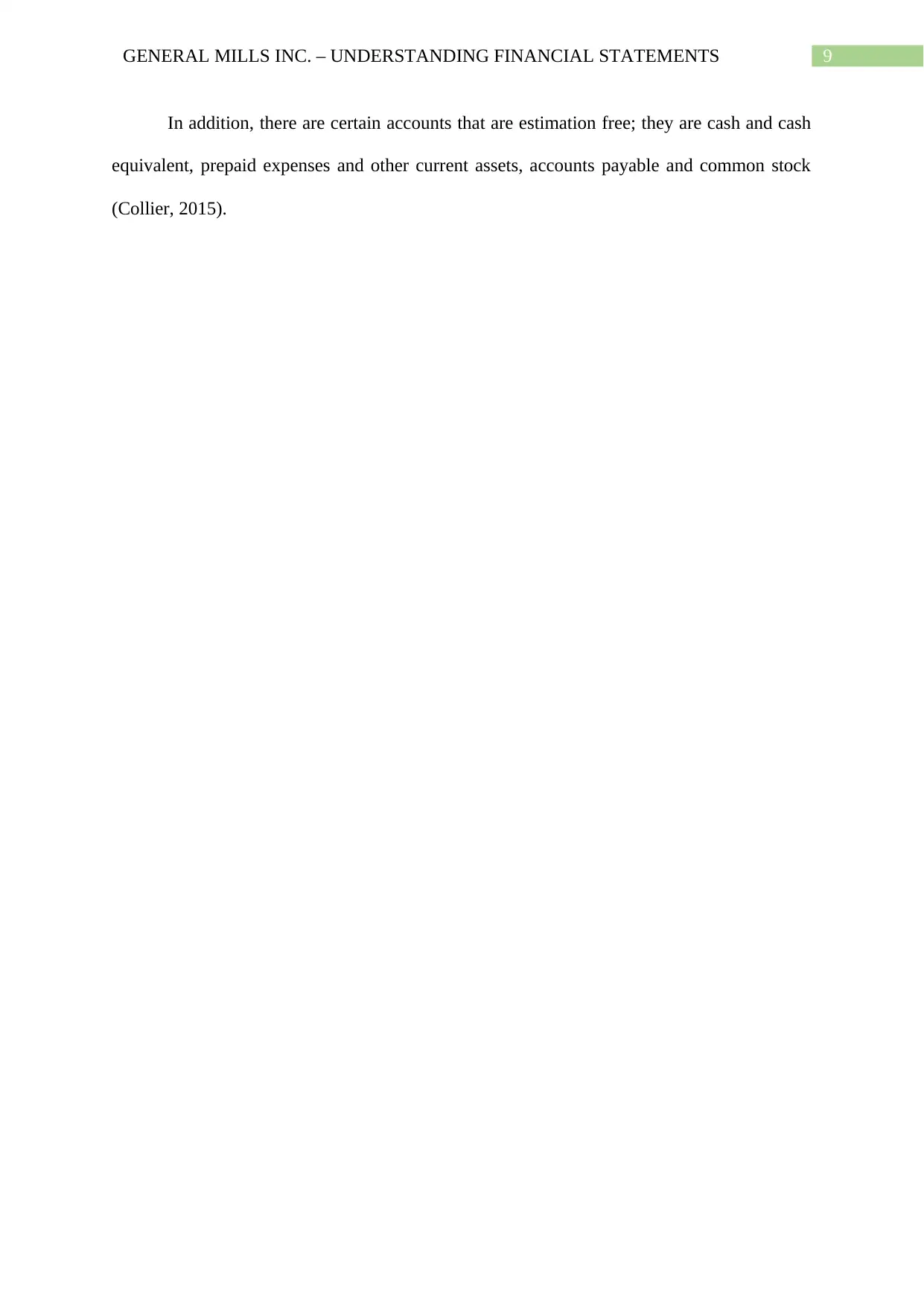
9GENERAL MILLS INC. – UNDERSTANDING FINANCIAL STATEMENTS
In addition, there are certain accounts that are estimation free; they are cash and cash
equivalent, prepaid expenses and other current assets, accounts payable and common stock
(Collier, 2015).
In addition, there are certain accounts that are estimation free; they are cash and cash
equivalent, prepaid expenses and other current assets, accounts payable and common stock
(Collier, 2015).
Secure Best Marks with AI Grader
Need help grading? Try our AI Grader for instant feedback on your assignments.
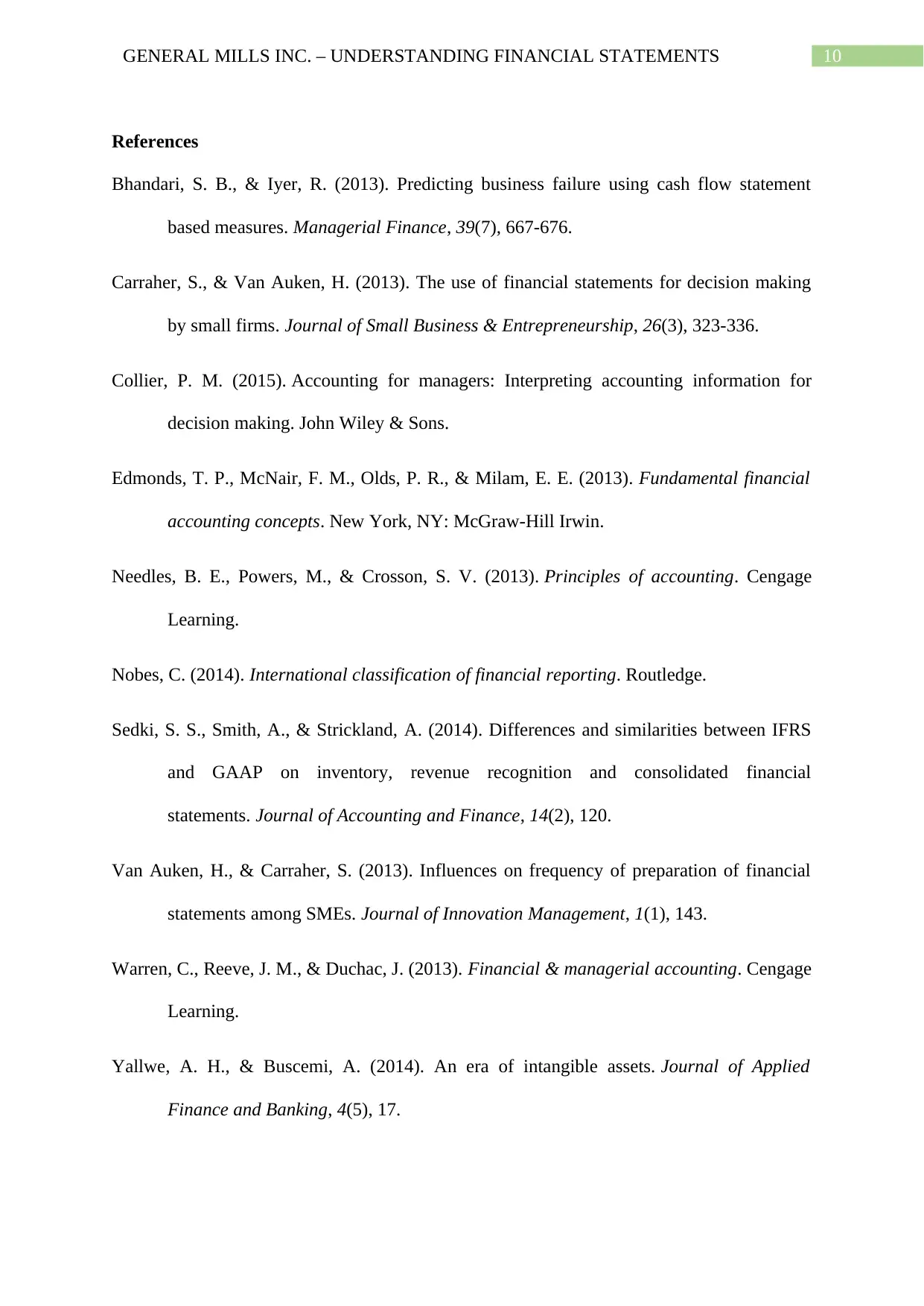
10GENERAL MILLS INC. – UNDERSTANDING FINANCIAL STATEMENTS
References
Bhandari, S. B., & Iyer, R. (2013). Predicting business failure using cash flow statement
based measures. Managerial Finance, 39(7), 667-676.
Carraher, S., & Van Auken, H. (2013). The use of financial statements for decision making
by small firms. Journal of Small Business & Entrepreneurship, 26(3), 323-336.
Collier, P. M. (2015). Accounting for managers: Interpreting accounting information for
decision making. John Wiley & Sons.
Edmonds, T. P., McNair, F. M., Olds, P. R., & Milam, E. E. (2013). Fundamental financial
accounting concepts. New York, NY: McGraw-Hill Irwin.
Needles, B. E., Powers, M., & Crosson, S. V. (2013). Principles of accounting. Cengage
Learning.
Nobes, C. (2014). International classification of financial reporting. Routledge.
Sedki, S. S., Smith, A., & Strickland, A. (2014). Differences and similarities between IFRS
and GAAP on inventory, revenue recognition and consolidated financial
statements. Journal of Accounting and Finance, 14(2), 120.
Van Auken, H., & Carraher, S. (2013). Influences on frequency of preparation of financial
statements among SMEs. Journal of Innovation Management, 1(1), 143.
Warren, C., Reeve, J. M., & Duchac, J. (2013). Financial & managerial accounting. Cengage
Learning.
Yallwe, A. H., & Buscemi, A. (2014). An era of intangible assets. Journal of Applied
Finance and Banking, 4(5), 17.
References
Bhandari, S. B., & Iyer, R. (2013). Predicting business failure using cash flow statement
based measures. Managerial Finance, 39(7), 667-676.
Carraher, S., & Van Auken, H. (2013). The use of financial statements for decision making
by small firms. Journal of Small Business & Entrepreneurship, 26(3), 323-336.
Collier, P. M. (2015). Accounting for managers: Interpreting accounting information for
decision making. John Wiley & Sons.
Edmonds, T. P., McNair, F. M., Olds, P. R., & Milam, E. E. (2013). Fundamental financial
accounting concepts. New York, NY: McGraw-Hill Irwin.
Needles, B. E., Powers, M., & Crosson, S. V. (2013). Principles of accounting. Cengage
Learning.
Nobes, C. (2014). International classification of financial reporting. Routledge.
Sedki, S. S., Smith, A., & Strickland, A. (2014). Differences and similarities between IFRS
and GAAP on inventory, revenue recognition and consolidated financial
statements. Journal of Accounting and Finance, 14(2), 120.
Van Auken, H., & Carraher, S. (2013). Influences on frequency of preparation of financial
statements among SMEs. Journal of Innovation Management, 1(1), 143.
Warren, C., Reeve, J. M., & Duchac, J. (2013). Financial & managerial accounting. Cengage
Learning.
Yallwe, A. H., & Buscemi, A. (2014). An era of intangible assets. Journal of Applied
Finance and Banking, 4(5), 17.
1 out of 11
Related Documents
Your All-in-One AI-Powered Toolkit for Academic Success.
+13062052269
info@desklib.com
Available 24*7 on WhatsApp / Email
![[object Object]](/_next/static/media/star-bottom.7253800d.svg)
Unlock your academic potential
© 2024 | Zucol Services PVT LTD | All rights reserved.




